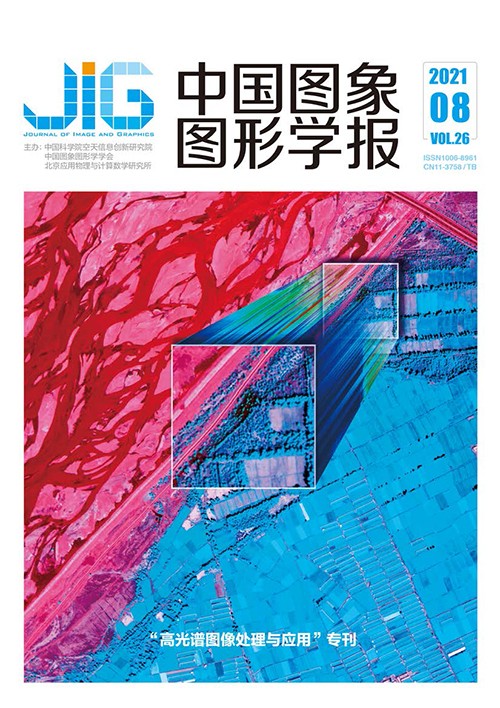
波段自适应细节注入的高分五号与Sentinel-2遥感影像空谱融合
摘 要
目的 针对当前空谱融合方法应用到高光谱图像融合时,出现的空间细节信息提升明显但光谱失真,或者光谱保真度高但空间细节信息提升不足的问题,本文提出一种波段自适应细节注入的高分五号(GF-5)高光谱图像(30 m)与Sentinel-2多光谱图像(10 m)的遥感影像空谱融合方法。方法 首先,为了解决两个多波段图像不便于直接融合的问题,提出一种波段自适应的融合策略,对多光谱图像波谱范围以外的高光谱图像波段,以相关系数为标准将待融合图像进行分组。其次,针对传统Gram-Schmidt (GS)融合方法用平均权重系数模拟低分辨率图像造成的光谱失真问题,使用最小均方误差估计计算线性拟合系数,再将拟合图像作为第1分量进行GS正变换,提升融合图像的光谱保真度。最后,为了能同时注入更多的空间细节信息,通过非下采样轮廓波变换将拟合图像、空间细节信息图像和多光谱图像的空间、光谱信息融入到重构的高空间分辨率图像中,再将其与其他GS分量一起进行逆变换,最终得到10 m分辨率的GF-5融合图像。结果 通过与当前用于高光谱图像空谱融合的典型方法比较,本文方法对于受时相影响较小的城镇区域,在提升空间分辨率的同时有较好的光谱保真度,且不会出现噪点;对于受时相变化影响大的植被密集区域,本文方法融合图像有较好的清晰度和地物细节信息,且没有噪点出现。本文方法的CC (correlation coefficient)、ERGAS (erreur relative globale adimensionnelle de synthèse)和SAM (spectral angle mapper)相比于传统GS方法分别提升8%、26%和28%,表明本文方法的光谱保真度大大提高。结论 本文方法的结果空间上没有噪点且光谱曲线与原始光谱曲线基本保持一致,是一种兼具高空间分辨率和高光谱保真度的高光谱图像融合方法。
关键词
Spatial-spectral fusion based on band-adaptive detail injection for GF-5 and Sentinel-2 remote sensing images
Wang Hairong1,2, Guo Qing1, Li An1(1.Aerospace Information Research Institute, Chinese Academy of Sciences, Beijing 100094, China;2.School of Electronic, Electrical and Communication Engineering, University of Chinese Academy of Sciences, Beijing 100049, China) Abstract
Objective GaoFen-5 (GF-5) hyperspectral data are important hyperspectral data sources at present. However, its 30 m spatial resolution limits its extensive application. Spatial-spectral fusion can fully utilize data of high spatial resolution like multispectral image (MSI) and data of high spectral resolution like hyperspectral image (HSI). It aims to generate data with high spatial and spectral resolutions at the same time. The ratio of spatial resolution between the two fusion images is usually 4. The Sentinel-2 MSI, which is 10 m resolution, is moderate for fusion with GF-5 HSI. Some scholars have applied a few typical pan-sharpening methods for MSI and HSI fusion based on artificial dataset, such as component substitution and multiresolution analysis methods. Others have adopted some model-based algorithms, such as Bayesian and matrix factorization approaches. However, the result performed on artificial dataset obeys the Wald's protocol instead of the real dataset. The main problem in the methods mentioned above is that some methods enhance the spatial information obviously but distort its spectrum, while others have high spectral fidelity but insufficient enhancement in spatial information. Therefore, we propose a new fusion algorithm called spatial-spectral fusion based on band-adaptive detail injection for GF-5 and Sentinel-2 remote sensing images to obtain the fused image with enhanced spatial resolution and high spectral fidelity. This method is based on the Gram-Schmidt (GS) transform and the nonsubsampled contourlet transform (NSCT). Method First, the band-adaptive grouping strategy is proposed to solve the difficulty in directly fusing two multi-band images. Each band of the HSI is grouped into the most relevant band of the MSI according to the correlation coefficient. This grouping strategy also improves the spectral fidelity of the fused image to some extent. Second, the minimizing mean square error estimator is used to calculate the coefficient for generating the low-resolution MSI (LMSI) in GS transform, which reduces the spectral distortion caused by simulating the LMSI with average weight coefficients in the traditional GS fusion. Then, the GS transformation is applied for the LMSI and the HSI to obtain each GS component. Third, NSCT has advantages in image denoising and enhancement, which can improve the spatial details of the fused image. NSCT is applied on the MSI, the LMSI, and the detail image generated from their difference to obtain high- and low-frequency coefficients. Next, a new high-resolution MSI (HMSI) is produced using weighted strategies. The HMSI has high spatial resolution and some spectral information because the spatial and spectral information in MSI, LMSI, and detail image are integrated into the reconstructed HMSI. Finally, the first component of GS components is replaced with the HMSI, and the image of high spatial and spectral resolutions is generated through the GS inverse transformation. Result We perform experiments on the real GF-5 data and Sentinel-2 data with abundant feature types, such as buildings, roads, mountains, plants, water, farmland, and bare land, to verify the reliability and effectiveness of the proposed method. The standard deviation, entropy, universal image quality index, correlation coefficient (CC), erreur relative globale adimensionnelle de Synthèse (ERGAS), and spectral angle mapper (SAM) are used as the quantitative indices to evaluate the quality of the fusion images. Compared with the typical fusion methods, the proposed method has advantages in spatial resolution and spectral fidelity. This method can improve the spatial resolution and has good spectral fidelity for the urban area which is rarely affected by the time phase. The fused image is sharp and has no noise for the vegetation area which is greatly affected by time. Compared with the indices of the traditional GS method, the CC, ERGAS, and SAM of the proposed method are improved by 8%, 26%, and 28%, respectively, which indicates that the spectral fidelity of this method is greatly improved. In addition, spectral curve is an important index to evaluate the quality of HSI. The spectral quality of the fused image is evaluated by comparing the shape and numerical difference of the spectral curve between the fused image and the original HSI in each band. The result shows that the spectral curve of the proposed method is consistent with the original HSI and closer to the original HSI than the GS method. Conclusion We propose a new spatial-spectral fusion method based on band-adaptive detail injection. No noise is observed in the result, and the spectral curve is consistent with the original spectral curve. Experimental results show that the proposed method has high spatial resolution while mitigating spectral distortion. The high- and low-frequency coefficients of NSCT in the proposed method are reorganized by the weighted fusion rule. In the following research, the NSCT fusion rule can be improved to generate fusion images with better spatial details and higher spectral fidelity.
Keywords
remote sensing spatial-spectral fusion GaoFen-5 (GF-5) satellite Sentinel-2 satellite Gram-Schmidt (GS) transform nonsubsampled contourlet transform (NSCT) hyperspectral image multi-sensor
|



 中国图象图形学报 │ 京ICP备05080539号-4 │ 本系统由
中国图象图形学报 │ 京ICP备05080539号-4 │ 本系统由